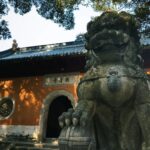
Wannian Temple, Tiantai: Zen Serenity and the Steadfast Pillars in the Depths of Time
Posted in :
Wannian Temple, renowned for the “Pillars of Wannian” among the “Four Wonders of Tiantai,” stands as one of the oldest monasteries in this sacred Buddhist region. Its origins can be traced back to the Eastern Jin Dynasty (317-420 AD), with some records suggesting its initial construction during the Tang Dynasty (around 833 AD, originally named Shouchang Temple). By the Song Dynasty (960-1279 AD), it was officially named Wannian Temple and was once imperially commissioned to enshrine 516 Arhat statues, indicating its significant religious standing at the time.

Wannian Temple is not only a testament to the history of the Tiantai School of Buddhism but also a bridge for Sino-foreign cultural exchange. Throughout history, many Japanese monks were drawn here, the most notable being Zen Master Eisai. He studied Tiantai doctrines and, crucially, brought tea seeds and tea processing techniques back to Japan, profoundly influencing the formation and development of the Japanese tea ceremony. Today, having weathered a millennium of changes, this ancient monastery continues its quiet existence and now serves as the seat of the Tiantai School Buddhist College, undertaking the mission of nurturing monastics and passing on the Dharma. Compared to the bustling Guoqing Temple, Wannian Temple is more like a reclusive practitioner, silently guarding the memories of time, awaiting those destined to visit.

Upon entering Wannian Temple, the first sight to greet you are the three magnificent Cryptomeria fortunei trees, nearly a thousand years old. Vigorous and verdant, they stand like “stalwart pillars,” giving rise to the temple’s famous epithet, the “Pillars of Wannian.” They seem to be faithful guardians of history, having witnessed the temple’s rises and falls, while adding an air of profound solemnity and ancient simplicity.

The temple’s architecture is simple and elegant. The deep mountain gate leads you into a realm of tranquility. Inside the Mahavira Hall, the Buddha statues are solemn and dignified; amidst the curling incense smoke, one feels an immense sense of inner peace. Strolling along the serene paths of the Zen courtyard, flanked by towering ancient trees, the interplay of light and shadow evokes the echoes of morning bells and evening drums reverberating through the valley. Whether it’s the play of light on a sunny day or the misty poetry of a rainy encounter, every detail of Wannian Temple feels vivid and profound. There is little clamor here, only the songs of birds, the fragrance of flowers, and the gentle hum of Buddhist chants, making it an ideal place to experience “Zen shadows in time” and engage in a dialogue with history. Surrounded by verdant mountains, the temple exudes an atmosphere of serene remoteness, far from the worldly bustle.




Wannian Temple
- (Sometimes referred to as “Wannian Chan Temple” reflecting its Zen characteristics, but “Wannian Temple” is the commonly accepted English name.)
- Address:Wannian Mountain Foothills, about 15 km northwest of Tiantai County Town, Taizhou City, Zhejiang Province, China.
- (For navigation, search “天台万年寺” or “万年禅寺” in Chinese GPS/map apps. If using English maps, try “Wannian Temple, Tiantai, Taizhou.”)
- (Wannian Temple is situated in the northern part of Tiantai County, near scenic spots like Yingke Ridge and Longchuan Gorge, and is relatively close to the Shiliang Waterfall area. It’s not clustered with Guoqing Temple and Tatou Temple in the Guoqing Scenic Area, so a separate travel plan for it is advisable.)
